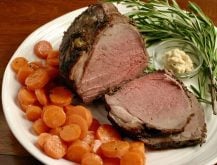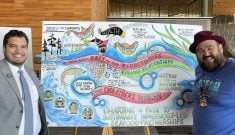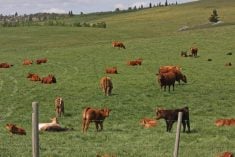The authors believe that the technology needed to produce food on the red planet could also benefit farmers on Earth
How could a human colony on Mars feed itself?
That’s the thought experiment food system writers Evan Fraser and Lenore Newman set themselves in their book, Dinner on Mars.
The red planet is brutally cold, lashed with harsh solar radiation, regularly hit by meteorites and generally unwelcoming to human life. It has no native vegetation and its only water is frozen within its sketchy soil.
It’s much too far to ship food from Earth, so future colonists will have to be able to produce most of what they need to consume.
Read Also

Know what costs are involved in keeping crops in the bin
When you’re looking at full bins and rising calf prices, the human reflex is to hold on and hope for more. That’s not a plan. It’s a bet. Storage has a price tag.
How will they do it?
Newman’s and Evans’ comprehensive answer to that question includes numerous technologies that, they believe, might be only a few years away, as well as a systemic approach that wastes nothing and revolves nutrients in a virtuous circle.
Within protected structures, highly productive crops bioengineered to contain valuable compounds will grow from the Martian soil and water, producing the macro and micronutrients needed by the colonists. Bacteria and algae will produce some of the food components. Food factories will grow meat from meat cells rather than relying upon living livestock, which will probably have no place on Mars.
3D printing will be used to turn some of the ingredients and components into palatable foods that the hardworking colonists won’t reject or feel depressed by.
Robots and other automation will play a major role in Martian agriculture, with human labour at a daunting premium.
Nanotechnology will help produce and extract top quality nutrition and exploit every element of whatever can be produced.
The farms won’t be anything like those on Earth, but food production will be everywhere, as the colony exploits every beam of weak sunlight. Humans will crave plant life and care for it. What isn’t eaten will be composted and recycled.
Near the end of the book Newman and Evans imagine a gourmet night out on the colony.
They start with a greenhouse-grown salad with grown-from-cells tuna followed by a main of a curry of LED-light grown red beans topped with a fermentation-produced form of sour cream, with mango sticky rice in a coconut syrup for dessert.
A tunnel vineyard provided the grapes for their Martian wine, while advanced fermentation produces a Martian bourbon whisky. A Martian coffee comes from fermentation as well.
The average daily repast wouldn’t be so grand.
“For breakfast, the average Martian would probably consume some kind of a nutrient-dense bar that would be algae-based. This might be flavoured with insect protein but most of the insects would be used to feed fish,” they write.
“Since carbohydrate-rich grain crops take so much space, breakfast bagels are unlikely to feature prominently, but omelettes from cellular agricultural bioreactors could be served with a side of hashbrowns made with real potatoes fertilized by composted waste organics collected from the refractories and eating halls. For cooking oil to cook the spuds, algae oil is likely to be in widespread use as it has a neutral flavour and a high smoke point….
“The milk or creamer for the hot beverage would almost certainly be a mixture of plant and yeast-fermented dairy fats and proteins….
“Along with the salad, we imagine folks eating a 3D-printed fish or chicken cutlet where the proteins are either grown in a bioreactor or are derived by yeasts…. For additional protein, there would likely be some yeast-derived cheese added to the salad.”
The book is written in a jaunty style with frequent humour, as well as journeys into agriculture and food history. Much of it is in the form of conversations between Evans and Newman, based upon Zoom-based discussions they had thinking through the experiment during the pandemic.
Newman is a food researcher with the University of the Fraser Valley. Evans is the director of the Arrell Food Institute at the University of Guelph.
Dinner on Mars hopes to be much more than a science-fiction-like thought experiment. It also hopes to provide ideas and applications for challenges on Earth, which they feel faces terrible environmental, climate and ethical food challenges.
With stunning developments in so many areas of agriculture and food, such as automation, robotics, fermentation, bioengineering, nanotechlogy and 3D printing, transforming the world’s farming and food system seems possible if the possibilities are realized.
“Our hope is that through books like this, we and others will throw down a trail of breadcrumbs that other scientists, politicians and industry leaders will follow until we reach a point where it will seem that the old 20th century ways of doing agriculture look prehistoric,” they write.
“We hope that in the not-too-distant future we all look back at the early 2020s as what we’d like to call Peak Farmland, Peak Meat, and Peak Water.”
Evans is a reluctant omnivore, eating meat but appearing to have reservations about how livestock are raised. Newman is an outright vegan and an opponent of meat production. The book contains numerous attacks on livestock production, often portraying it as inhumane as well as arguing that having livestock on pastures and grasslands is a significant cause of climate change.
The authors advocate restricting the expansion of crop acres and a slashing of livestock numbers.
“We cannot meaningfully expand our cropland any further and we must shrink our pastureland. The number of cows, pigs and chickens on the planet needs to drop dramatically.”
The book contains little in the way of counterarguments from those who feel that livestock play a vital role in protecting grasslands and have a natural place in the cycling of nutrients on pasturelands.
While painting the future of the Earth as bleak if it follows its current trajectory of climate change and environmental degradation, the authors say they are optimists and see much hope in today’s cutting-edge technologies allowing for sustainable farming systems to replace today’s less efficient means.
If the daunting environmental challenges of producing food on Mars can be successfully tackled, then those on Earth can surely be solved as well, they believe.
















